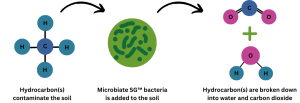Cart
What is bioremediation?
Bioremediation is a type of biotech that uses living organisms to break down contaminants, pollutants, or toxins. Bioremediation methods can be employed in many environments, including soil and water. The decontaminating organisms in question are usually fungi (in a process called phytoremediation) or microbes. They are naturally geared towards biodegrading contaminants, such as oil and other petroleum products, solvents, and pesticides. At BioNorth Solutions, we employ microbes in our products to degrade oil and fuels.
The biodegradation (or breakdown, if you will) of contaminants results in the production of water and carbon dioxide, which are returned to the environment. Once degradation is complete, the contaminants are gone and the environment is left cleaner.
Bioremediation can be used in-situ (treatment at contaminated sites) or ex-situ (treatment of excavated contaminated soil or water). Nutrients and specialized microorganisms are added in both cases to stimulate bioremediation processes. Treatment times can vary, as it is a natural process occurring in a natural environment. Many factors can affect how long it takes for contaminants to be completely removed – temperature, moisture, competing microorganisms, the type of contaminant, and the size of the contaminated area.
What are the advantages of bioremediation?
Sustainable and eco-friendly
Microbes are nature’s clean-up crew! Many microorganisms found in soils are naturally geared towards degrading pollutants and contaminants. These microorganisms can be introduced to other soils, in a process called biostimulation, to safely clean contamination and promote a healthy soil ecosystem.
Cost-effective
Bioremediation is cheaper than traditional methods, such as ‘dig and dump’.. Bioremediation also reduces the costs of labour and equipment – let the microbes do the remediation work for you!
Scalable
Whether you have a small spill or a large contaminated industrial site, bioremediation can accommodate your needs. Bioremediation is suitable for in-situ or ex-situ purposes, to treat the site directly or to treat biopiles.
Versatile and project friendly
Bioremediation can be used in many different scenarios and environments. Soil, water, and waste can be remediated using microorganisms such as bacteria and fungi. This methodology is commonly used to treat industrial sites, petroleum and crude oil refineries, landfills, lumber processing facilities, as well as waste management and sanitation facilities.
Bioremediation can be applied in complement with traditional methods, such as chemox, ‘dig and dump’, and natural attenuation, to offset environmental disturbance. It can be useful where other methods cannot be applied, such as for cleaning under buildings or residual contamination.
Microbiate SG™ contains a proprietary blend of microbes that are cold-adapted to allow for a wide range of working temperatures (0.01-49℃), allowing for a longer remediation season and a greater climate reach.
History of Bioremediation
As clean tech gains more and more traction in use, bioremediation may seem like a somewhat recent biotechnological development in the industry. In reality, bioremediation has been naturally occurring long before humans ever harnessed its power!
Some species of fungi and microbes (like the ones we use in Microbiate SG™) have existed for thousands of years, naturally degrading hydrocarbons and other contaminants in the environment to survive. As long as these fungi and microbes have been around, they’ve been performing bioremediation – no scientists needed!
In the 1940s, researchers began to take note of the natural cleaning power of microbes on oil spills in soil. By the 1970s, bioremediation had gained significant attention in the world of science. One of the earliest experiments involved the application of fertilizers to a contaminated beach in order to stimulate microbial growth. With a larger microbial population, hydrocarbon degradation is accelerated, effectively cleaning the beach. With advancements of genetic engineering in the 1980s and 1990s, scientists were able to enhance the degradation abilities of microbes, further refining effective bioremediation techniques.
Bioaugmentation (introducing beneficial strains to contaminated sites) and biostimulation (adding nutrients to stimulate the growth of existing microbial populations) are two techniques that are widely used in bioremediation methodology today.
Today, bioremediation has become a trusted, effective, and well-known method for cleaning and treating environmental contamination. Bioremediation has many uses, whether for oil spill clean up, industrial waste and landfill treatment, and agricultural detoxification. The field of bioremediation continues to evolve, offering sustainable solutions to some of the most pressing environmental challenges of our time. As we move forward, this synergy between nature and technology promises a cleaner and healthy planet.



